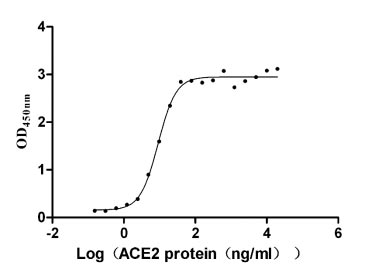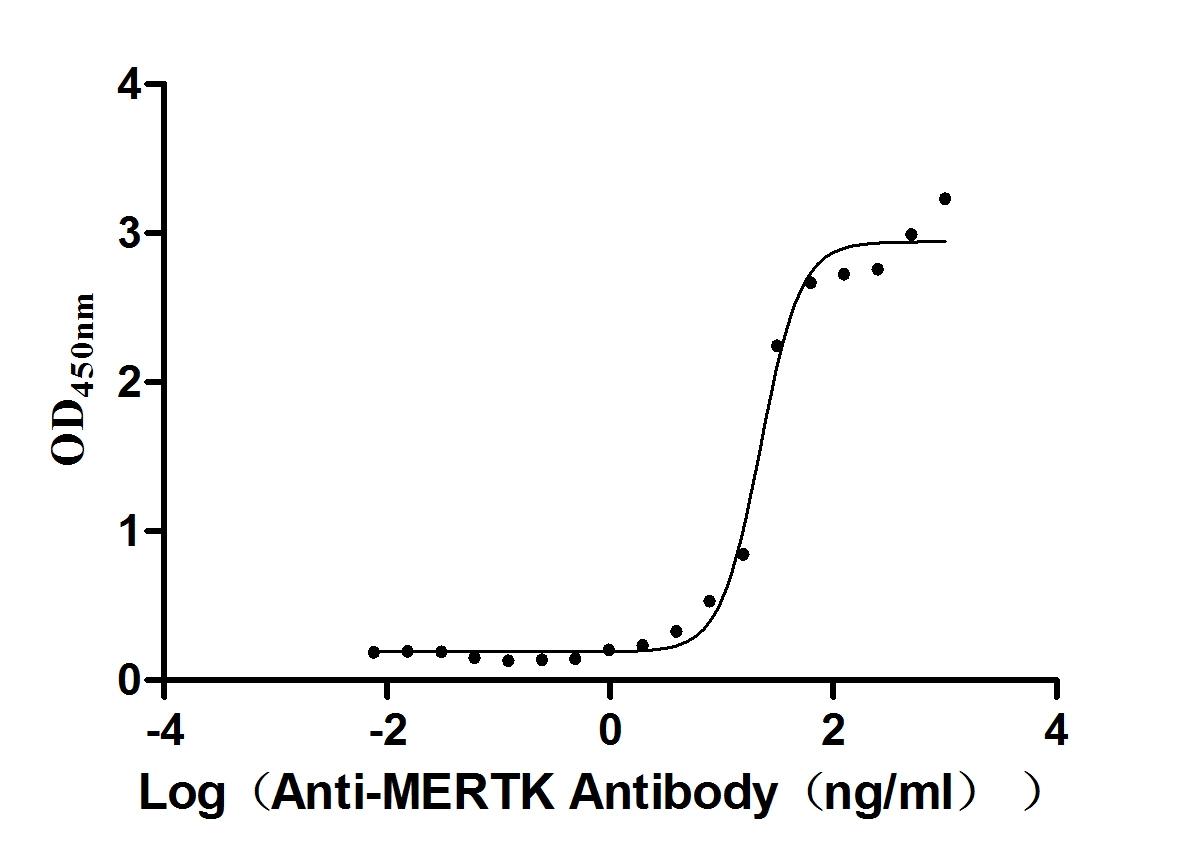Recombinant Mouse Krueppel-like factor 10 (Klf10)
-
货号:CSB-YP012384MO
-
规格:
-
来源:Yeast
-
其他:
-
货号:CSB-EP012384MO
-
规格:
-
来源:E.coli
-
其他:
-
货号:CSB-EP012384MO-B
-
规格:
-
来源:E.coli
-
共轭:Avi-tag Biotinylated
E. coli biotin ligase (BirA) is highly specific in covalently attaching biotin to the 15 amino acid AviTag peptide. This recombinant protein was biotinylated in vivo by AviTag-BirA technology, which method is BriA catalyzes amide linkage between the biotin and the specific lysine of the AviTag.
-
其他:
-
货号:CSB-BP012384MO
-
规格:
-
来源:Baculovirus
-
其他:
-
货号:CSB-MP012384MO
-
规格:
-
来源:Mammalian cell
-
其他:
产品详情
-
纯度:>85% (SDS-PAGE)
-
基因名:Klf10
-
Uniprot No.:
-
别名:Klf10; Gdnfif; Tieg; Tieg1Krueppel-like factor 10; GDNF-inducible factor; Transcription factor GIF; mGIF; Transforming growth factor-beta-inducible early growth response protein 1; TGFB-inducible early growth response protein 1; TIEG-1
-
种属:Mus musculus (Mouse)
-
蛋白长度:Full length protein
-
表达区域:1-479
-
氨基酸序列MLNFGASLQQ ASEGKMELIS EKPREGMHPW DKAEQSDFEA VEALMSMSCD WKSHFKKYLE NRPVTPVSDT SEDDSLLPGT PDLQTVPAFC LTPPYSPSDF EPSQGSNLTA SAPSTGHFKS FSDAAKPPGA TPFKEEEKNP LAAPPLPKAQ ATSVIRHTAD AQLCNHQSCP VKAASILNYQ DNSFRRRTHG NVEATRKNIP CAAVSPNRSK PEPSTVSDGD EKAGAALYDF AVPSSETVIC RSQPAPSSPV QKSVLVSSPT VSTGGVPPLP VICQMVPLPA NNSLVSTVVP STPPSQPPAV CSPVLFMGTQ VPEGTVVFVV PQPVVQSPRP PVVSPSGTRL SPIAPAPGFS PSAARVTPQI DSSRVRSHIC SHPGCGKTYF KSSHLKAHVR THTGEKPFSC SWKGCERRFA RSDELSRHRR THTGEKKFAC PMCDRRFMRS DHLTKHARRH LSAKKLPNWQ MEVSKLNDIA LPPTPASAQ
-
蛋白标签:Tag type will be determined during the manufacturing process.
The tag type will be determined during production process. If you have specified tag type, please tell us and we will develop the specified tag preferentially. -
产品提供形式:Lyophilized powder
Note: We will preferentially ship the format that we have in stock, however, if you have any special requirement for the format, please remark your requirement when placing the order, we will prepare according to your demand. -
复溶:We recommend that this vial be briefly centrifuged prior to opening to bring the contents to the bottom. Please reconstitute protein in deionized sterile water to a concentration of 0.1-1.0 mg/mL.We recommend to add 5-50% of glycerol (final concentration) and aliquot for long-term storage at -20℃/-80℃. Our default final concentration of glycerol is 50%. Customers could use it as reference.
-
储存条件:Store at -20°C/-80°C upon receipt, aliquoting is necessary for mutiple use. Avoid repeated freeze-thaw cycles.
-
保质期:The shelf life is related to many factors, storage state, buffer ingredients, storage temperature and the stability of the protein itself.
Generally, the shelf life of liquid form is 6 months at -20°C/-80°C. The shelf life of lyophilized form is 12 months at -20°C/-80°C. -
货期:Delivery time may differ from different purchasing way or location, please kindly consult your local distributors for specific delivery time.Note: All of our proteins are default shipped with normal blue ice packs, if you request to ship with dry ice, please communicate with us in advance and extra fees will be charged.
-
注意事项:Repeated freezing and thawing is not recommended. Store working aliquots at 4°C for up to one week.
-
Datasheet :Please contact us to get it.
靶点详情
-
功能:Transcriptional repressor which binds to the consensus sequence 5'-GGTGTG-3'. May play a role in the cell cycle regulation. Plays a role in the regulation of the circadian clock; binds to the GC box sequence in the promoter of the core clock component ARTNL/BMAL1 and represses its transcriptional activity. Regulates the circadian expression of genes involved in lipogenesis, gluconeogenesis, and glycolysis in the liver. Represses the expression of PCK2, a rate-limiting step enzyme of gluconeogenesis.
-
基因功能参考文献:
- KLF10 and atrial natriuretic peptide/NPRA in exerting influences on chronic pulmonary disease pathogenesis PMID: 27592451
- s demonstrate that targeting the SDF-1/CXCR4 pathway in the context of KLF10 deletion substantially suppresses PDAC progression. PMID: 28581520
- In an animal endometriosis model, unlike wild-type controls, Klf10(-/-) animals developed cystic lesions with massive immune infiltrate and minimal peri-lesional fibrosis. The Klf10(-/-) disease progression phenotype also contrasted with prolific fibrosis and minimal immune cell infiltration seen in Klf11(-/-) animals. PMID: 27488034
- TIEG1 is involved in regulating the canonical Wnt signaling pathway in bone through multiple mechanisms of action. PMID: 28201653
- In clinical specimens of lung adenocarcinoma, low KLF10 expression associated with decreased patient survival, consistent with a pivotal role for KLF10 in distinguishing the antiproliferative versus prometastatic functions of TGFbeta. Our results establish that KLF10 functions to suppress TGFb-induced EMT, establishing a molecular basis for the dichotomy of TGFb function during tumor progression. PMID: 28249899
- This study further implicates important roles for TIEG1 in the development of skeletal muscle and suggests that defects in TIEG1 expression and/or function may be associated with muscle disease. PMID: 27421714
- Study has provided new insights into the role of TIEG1 in the functional and morphological properties of fast and slow twitch skeletal muscles. PMID: 27736981
- our findings indicate that the absence of TIEG1 plays a cardioprotective role in ischaemic heart disease by promoting changes in Pten/Akt signalling. PMID: 28204828
- Klf10 is involved in tooth development and promotes odontoblastic differentiation via the up-regulation of Dmp1 and Dspp transcription. PMID: 26310138
- KLF10 deficiency predisposes to colitis through epigenetic regulation of TGFBRII expression and colonic macrophage dysregulation. PMID: 26472224
- The KLF10 KO condition may reinforce the TGF-betaSmad signaling pathway. PMID: 25682863
- these data implicate an important role for TIEG1 in mediating estrogen signaling throughout the mouse skeleton and suggest that defects in this pathway are likely to contribute to the sex-specific osteopenic phenotype PMID: 24190163
- up-regulation of KLF10 was accompanied by increased TGFbeta signaling genes and suppressed ChREBP expression. These observations suggest possible association of KLF10 and NASH progression PMID: 24986741
- To explore the role of KLF10 as an antiinflammatory factor in skin inflammation, we employed the phthalic anhydride-induced dermatitis model. These results support the role of KLF10 as an anti-inflammatory factor in chemical-induced skin inflammation. PMID: 23707674
- RAF-1 phosphorylation and PIN1 isomerization together regulate KLF10 stability and further affect the role of KLF10 in tumor progression. PMID: 23994618
- Demonstrate a protective role for bone marrow-derived KLF10 in paracrine and homing responses important for arterial endothelial injury. PMID: 23685559
- KLF10 induces COX-1 protein expression and mRNA expression in endothelial cells. PMID: 23178857
- Klf10 is a transcription factor that regulates the expression of IL-12p40 in bone marrow-derived macrophages. PMID: 23065757
- TIEG1 knockout (TIEG1-/-) mice have a delay in wound closure related to an impairment in wound contraction, granulation tissue formation, collagen synthesis, and reepithelialization. PMID: 22380689
- This study demonstrates that KLF10 is a tumor suppressor and that it targets p21(WAF1/CIP1) transcription. PMID: 22349513
- Data from studies with knockout mice suggest that identify KLF10 and TGFbeta1 are key regulators of functional proangiogenic cells derived from bone marrow (i.e., myeloid progenitor cells and granulocyte-macrophage progenitor cells). PMID: 21828131
- Tieg1 suppresses mammary tumorigenesis in xenografts in mice, and decreases lung metastasis by inhibition of Egfr gene transcription and the Egfr signaling pathway. PMID: 22025675
- TIEG1 has a role in regulating the expression and activity of Runx2 in osteoblasts PMID: 21559363
- Growth of TRAMP-C2 tumor was reduced in TIEG1 deficient mice and was accompanied by reduced Foxp3+ Tregs and an elevated Th17 response, suggesting that TIEG1 deficiency tilted the balance from suppressive toward effector immunity. PMID: 21471442
- Increased AKT and MEK/ERK signaling pathway activation in TIEG1(-/-) osteoclasts was observed, consistent with the roles of these kinases in promoting osteoclast survival. PMID: 21423731
- TIEG1 is a negative regulator of the myoblast pool that causes inhibition of myotube formation during myogenic differentiation. PMID: 20945337
- These data further elucidate the role of TIEG1 on tendon structure and could explain the previous defects in the structure-function relationship found for TIEG1 KO tendon fibers. PMID: 20378701
- Transcriptional repressor TIEG1 regulates Bmal1 gene through GC box and controls circadian clockwork. PMID: 20070857
- the expression of TIEG1 and TIEG2 was specific in different organs yet varied with different developmental time points. PMID: 20201061
- These data establish KLF10 as a required circadian transcriptional regulator that links the molecular clock to energy metabolism in the liver. PMID: 20385766
- these results confirm that TIEG directly binds to and inhibits OPG promoter activity in osteoblasts(OBs), partially explaining the inability of TIEG KO OBs to fully support osteoclast differentiation. PMID: 20059964
- the bones of TIEG1 knockout mice display an osteopenic phenotype with significantly weaker bones and reduced amounts of cortical and trabecular bone PMID: 16876494
- report a novel finding in the TGFbeta inducible early gene (TIEG) null mouse implicating TIEG1 in cardiac hypertrophy PMID: 16888812
- Tieg1 induces apoptosis through mitochondrial apoptotic pathway and promotes apoptosis induced by homoharringtonine and velcade. PMID: 17659279
- Results suggest that female TIEG(-/-) mice are osteopenic mainly due to a decrease in the total number of functional/mature osteoblasts. PMID: 18396127
显示更多
收起更多
-
亚细胞定位:Nucleus.
-
蛋白家族:Sp1 C2H2-type zinc-finger protein family
-
数据库链接:
KEGG: mmu:21847
STRING: 10090.ENSMUSP00000073690
UniGene: Mm.4292
Most popular with customers
-
Recombinant Human SARS coronavirus Spike glycoprotein (S), partial (Active)
Express system: Mammalian cell
Species: Human SARS coronavirus (SARS-CoV) (Severe acute respiratory syndrome coronavirus)
-
Recombinant Mouse Prolactin receptor (Prlr), partial (Active)
Express system: Mammalian cell
Species: Mus musculus (Mouse)
-
Recombinant Mouse Tyrosine-protein kinase Mer (Mertk), partial (Active)
Express system: Mammalian cell
Species: Mus musculus (Mouse)
-
Recombinant Human Claudin-3 (CLDN3)-VLPs (Active)
Express system: Mammalian cell
Species: Homo sapiens (Human)
-
Recombinant Mouse Cell adhesion molecule 1 (Cadm1), partial (Active)
Express system: Mammalian cell
Species: Mus musculus (Mouse)
-
Recombinant Human Interleukin-1 receptor accessory protein (IL1RAP), partial (Active)
Express system: Mammalian cell
Species: Homo sapiens (Human)


















